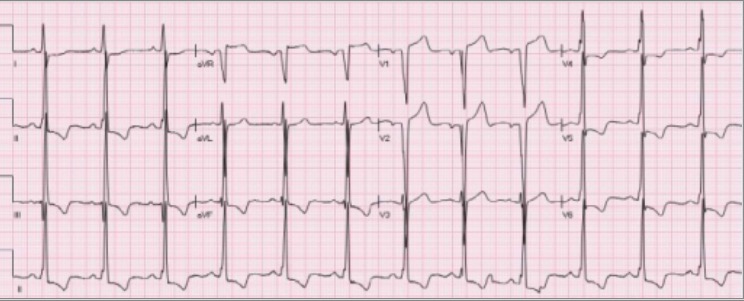Playlist
Show Playlist
Hide Playlist
Systemic (Left-sided) Hypertensive Heart Disease
-
Slides Valvular Hypertensive Heart Disease.pdf
-
Reference List Pathology.pdf
-
Download Lecture Overview
00:00 So, just going to highlight these things again. Left ventricular hypertrophy in the absence of other cardiovascular pathology is hypertensive heart disease. We will find in other tissues evidence of hypertension. So, we can see glomerulosclerosis; we can see arteriolosclerosis; and that’s what’s being represented there on that trichrome stain. 00:24 The vessel wall becomes markedly thickened, with more extracellular matrix. So, we can have evidence of hypertension in other organs as well. So, that’s systemic left-sided hypertensive heart disease. How do we define hypertension? We’ve talked about this previously. It’s 120/80, is upper limits of normal. Anything above that is considered hypertension. And it’s a continuous variable. So, if you have 130/90 that’s modest degree of hypertension but it’s still hypertension. If you have 180/120, now we’re worried about very aggressive malignant hypertension, but anything greater than 120/80 is going to be something that we should be concerned about and try to reduce. 01:13 It’s very, very prevalent. So, in the age group where many of you are currently sitting, about a quarter of you will have some evidence of hypertension even now as you aged because the vessels get stiffer and there is a cumulative amount of small little insults that will lead to accumulation of hypertensive kind of insults. 55% of patients will have hypertension and hypertensive heart disease by the time they’re in their mid-50s. 01:48 And, 75% will have hypertension and hypertensive heart disease by the time that their age is 60 and older. It doesn’t necessarily mean you’re going to progress to heart failure, so only about a third of patients with the typical levels of hypertension that we see in the population will develop heart failure due to the fibrosis and then the pulmonary edema, etc. But, there is a three-fold increased risk of heart failure relative to patients who have normal pressures, so there’s a significant risk associated. Again, normal ventricle should have myocytes that look like what you see there, with longstanding hypertension, increased pressures against which the ventricle must pump, then you get hypertrophy. And, again, you don’t get concomitant increases in the capillary vasculature. So, we’re going to have large cells with the same number and density of capillaries and they’re going to be relatively ischemic in the middle. We’re also going to have increased fibrosis. Again, the fibroblasts that sit in between the cardiac myocytes are going to respond to that higher pressure differential by making more extracellular matrix. So, what are the signs and symptoms of hypertensive heart disease? Well, in fact, the vast majority of patients can be completely asymptomatic, sometimes until it’s too late. But, if we were to do an EKG or an electrocardiogram or an ECG, what we would see is very high voltages in many of the limb leads and also across the precordial leads. And that’s due to the increased muscle mass that’s present in this left ventricle. So, you see very high peaked QRS complexes and you see it there in 1, we can also see it in V1, we can also see it as well in AVL which is what's shown, and also you get nonspecific STT wave changes so you can get an abnormal depolarization, again presumably because of the increased muscle mass. So, there are changes that you can see on an ECG. So, what are the outcomes from hypertensive heart disease? Well, one, is that you’ll live as long as you’re going to live otherwise then you die of unrelated causes, you fall underneath the bus, whatever, something else happens. 04:21 Two, is that you can develop ischemic heart disease. Hypertension is a major risk factor for atherosclerotic disease. But we’re also going to have microvascular ischemia because, again, these individual cardiac myocytes are getting so big and the diffusion distances increasing from the nearby capillaries. So you can have ischemic heart disease. 04:42 You can have renal damage or cerebrovascular stroke, and again, remember, hypertension is going to damage those vascular beds, and with high blood pressure, you can rupture cerebral vessels or you can have progressive heart failure due to the mechanisms that we talked about, interstitial fibrosis with diastolic dysfunction, regurgitant flow through the mitral valve, pulmonary edema, atrial fibrillation. 05:07 So, there are a variety of outcomes. That’s left-sided hypertensive heart disease.
About the Lecture
The lecture Systemic (Left-sided) Hypertensive Heart Disease by Richard Mitchell, MD, PhD is from the course Valvular and Hypertensive Heart Disease.
Included Quiz Questions
What is the definition of blood pressure?
- The pressure of circulating blood on the walls of blood vessels
- The force of blood pumped into the heart
- The force of blood pumped out of the heart
- The number of contractions of the heart per minute
- The number of contractions of the heart per minute divided by the force exerted by each heartbeat
What change occurs in cardiomyocytes with hypertensive heart disease?
- Hypertrophy
- Atherosclerosis
- Luminal narrowing
- Pulmonary circulation congestion
- Iron deposition
Which group of patients has an increased risk of hypertensive heart disease?
- Geriatric patients
- Patients with low salt intake
- Anorexic patients
- Patients who sleep an average of nine hours each night
- Patients with a BMI between 20 and 24
Customer reviews
5,0 of 5 stars
| 5 Stars |
|
5 |
| 4 Stars |
|
0 |
| 3 Stars |
|
0 |
| 2 Stars |
|
0 |
| 1 Star |
|
0 |




